The iPhone 5 Performance Preview
by Anand Lal Shimpi on September 21, 2012 11:31 PM EST- Posted in
- Smartphones
- Apple
- Mobile
- SoCs
- iPhone 5
This morning we finally got our hands on Apple's iPhone 5. While we are eager to get started on battery life testing, that'll happen late tonight after a full day's worth of use and a recharge cycle. Meanwhile, we went straight to work on performance testing. As we've mentioned before, the A6 SoC makes use of a pair of Apple's own CPU cores that implement the ARMv7 ISA. These aren't vanilla Cortex A9s or Cortex A15s, but rather something of Apple's own design. For its GPU Apple integrated a PowerVR SGX543MP3 GPU running at higher clocks than the dual-core 543MP2 in the A5. The result is compute performance that's similar to the A5X in Apple's 3rd generation iPad, but with a smaller overall die area. The A6 has a narrower memory interface compared to the A5x (64-bits vs. 128-bits), but that makes sense given the much lower display resolution (0.7MP vs. 3.1MP).
As always, our performance analysis starts out on the CPU. Although we originally thought the A6 ran its two CPU cores at 1GHz, it looks like max clocks range between 800MHz and 1.2GHz depending on load. Geekbench reports clock speed at launch, which varied depending on CPU load. With an app download process in the background I got Geekbench to report a 1.2GHz clock speed, and with everything quiet in the background the A6 reported 800MHz after being queried. This isn't anything new as dynamic voltage/frequency adjustment is in all smartphones, but we do now have a better idea of the range.
The other thing I noticed is that without a network active I'm able to get another ~10% performance boost over the standard results while on a network. Take the BrowserMark results below for example, the first two runs are without the iPhone 5 being active on AT&T's network while the latter two are after I'd migrated my account over. The same was true for SunSpider performance, I saw numbers in the low 810ms range before I registered the device with AT&T.
Overall, the performance of the A6 CPU cores seems to be very good. The iPhone 4S numbers below are updated to iOS 6.0 so you can get an idea of performance improvement.
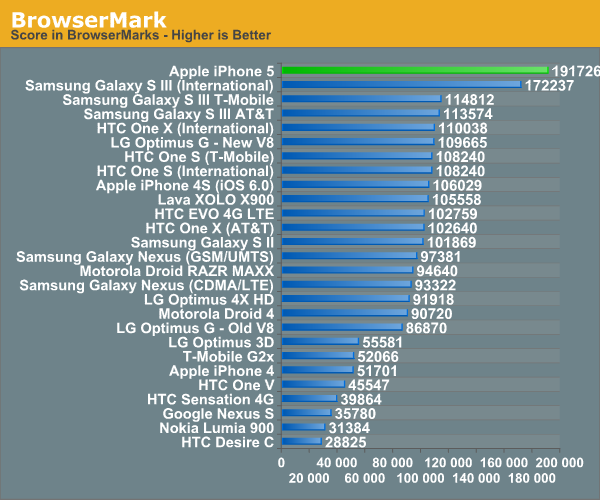
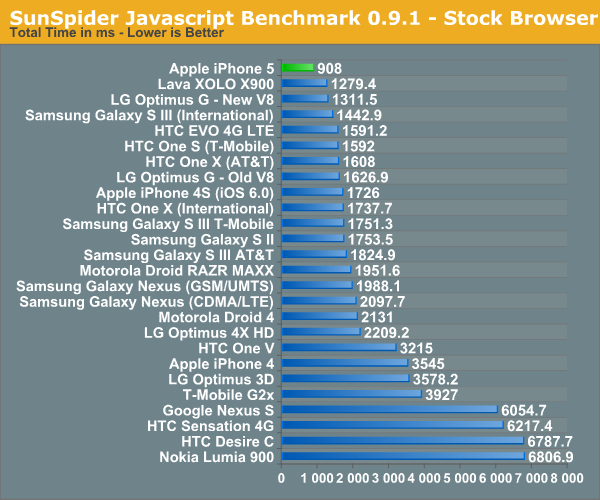
As we mentioned in our earlier post, SunSpider is a small enough benchmark that it really acts as a cache test. The memory interface on the A6 seems tangibly better than any previous ARM based design, and the advantage here even outpaces Intel's own Medfield SoC.
I also ran some data using Google's V8 and Octane benchmarks, both bigger JavaScript tests than SunSpider. I had an AT&T HTC One X with me while in New York today (up here for meetings this week) and included its results in the charts below. Note that the default HTC web browser won't run the full Octane suite so I used Chrome there. I didn't use Chrome for the V8 test because it produced lower numbers than the stock browser for some reason.
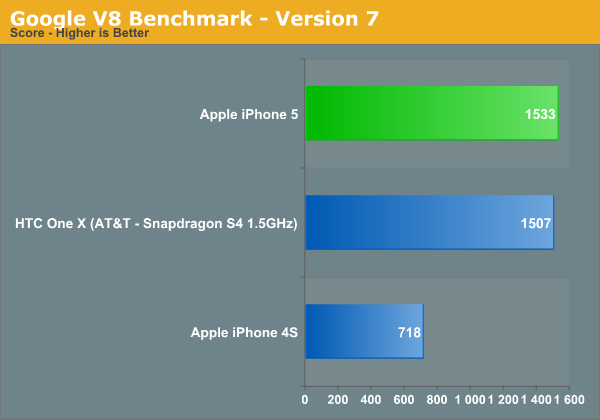
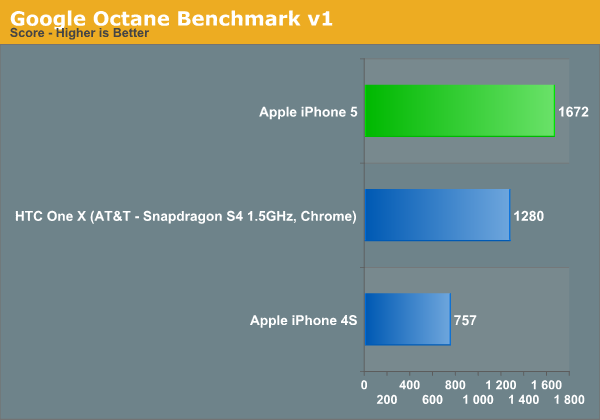
Here we see huge gains over the iPhone 4S, but much closer performance to the One X. In the case of Google's V8 benchmark the two phones are effectively identical, although Octane gives the iPhone 5 a 30% lead once more.
These are still narrowly focused tests, we'll be doing some more holisitic browser tests over the coming days. Finally we have Geekbench 2, comparing the iPhone 5 and 4S:
| Geekbench 2 Performance | ||||
| Geekbench 2 Overall Scores | Apple iPhone 4S | Apple iPhone 5 | ||
| Geekbench Score | 628 | 1640 | ||
| Integer | 545 | 1252 | ||
| Floating Point | 737 | 2101 | ||
| Memory | 747 | 1862 | ||
| Stream | 299 | 946 | ||
Apple claimed a 2x CPU performance advantage compared to the iPhone 4S during the launch event for the 5. How does that claim match up with our numbers? Pretty good actually:
This is hardly the most comprehensive list of CPU benchmarks, but on average we're seeing the iPhone 5 deliver 2.13x the scores of the iPhone 4S. We'll be running more application level tests over the coming days so stay tuned for those.
A6 GPU Performance: Nearly Identical to the iPad 3
Before we got a die shot of Apple's A6 we had good information pointing to a three core PowerVR SGX 543MP3 in the new design. As a recap, Imagination Technologies' PowerVR SGX543 GPU core features four USSE2 pipes. Each pipe has a 4-way vector ALU that can crank out 4 multiply-adds per clock, which works out to be 16 MADs per clock or 32 FLOPS. Imagination lets the customer stick multiple 543 cores together, which scales compute performance linearly. The A5 featured a two core design, running at approximately 200MHz based on our latest news. The A5X in the 3rd generation iPad featured a four core design, running at the same 200MHz clock speed.
The A6 on the other hand features a three core PowerVR SGX 543MP3, running at higher clock speeds to deliver a good balance of die size while still delivering on Apple's 2x GPU performance claim. The raw specs are below:
| Mobile SoC GPU Comparison | |||||||||||
| Adreno 225 | PowerVR SGX 540 | PowerVR SGX 543MP2 | PowerVR SGX 543MP3 | PowerVR SGX 543MP4 | Mali-400 MP4 | Tegra 3 | |||||
| SIMD Name | - | USSE | USSE2 | USSE2 | USSE2 | Core | Core | ||||
| # of SIMDs | 8 | 4 | 8 | 12 | 16 | 4 + 1 | 12 | ||||
| MADs per SIMD | 4 | 2 | 4 | 4 | 4 | 4 / 2 | 1 | ||||
| Total MADs | 32 | 8 | 32 | 48 | 64 | 18 | 12 | ||||
| GFLOPS @ 200MHz | 12.8 GFLOPS | 3.2 GFLOPS | 12.8 GFLOPS | 19.2 GFLOPS | 25.6 GFLOPS | 7.2 GFLOPS | 4.8 GFLOPS | ||||
| GFLOPS As Shipped by Apple/ASUS | - | - | 12.8 GFLOPS | 25.5 GFLOPS | 25.6 GFLOPS | - |
12 GFLOPS |
||||
The result is peak theoretical GPU performance that's near identical to the A5X in the 3rd generation iPad. The main difference is memory bandwidth. The A5X features a 128-bit wide memory interface while the A6 retains the same 64-bit wide interface as the standard A5. In memory bandwidth limited situations, the A5X will still be quicker but it's quite likely that at the iPhone 5's native resolution we won't see that happen.
We ran through the full GLBenchmark 2.5 suite to get a good idea of GPU performance. Note that the 3rd gen iPad results are still on iOS 5.1 so there's a chance you'll see some numbers change as we move to iOS 6.
We'll start out with the raw theoretical numbers beginning with fill rate:
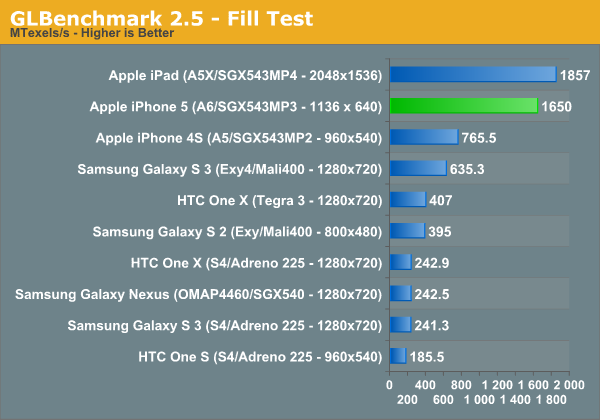
The iPhone 5 nips at the heels of the 3rd generation iPad here, at 1.65GTexels/s. The performance advantage over the iPhone 4S is more than double, and even the Galaxy S 3 can't come close.
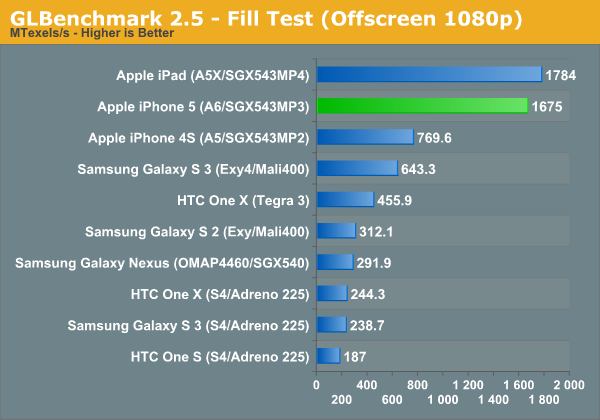
Triangle throughput is similarly strong:
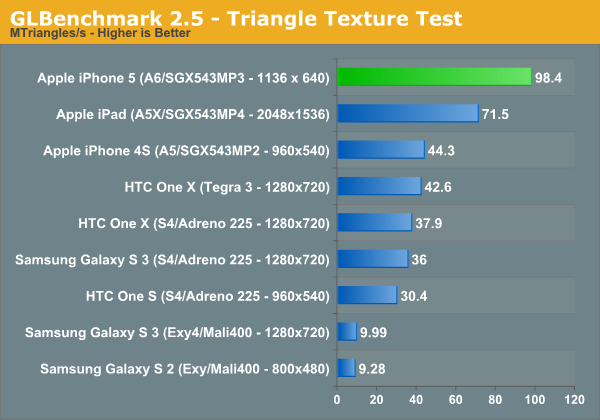
Take resolution into account and the iPhone 5 is actually faster than the new iPad, but normalize for resolution using GLBenchmark's offscreen mode and the A5X and A6 look identical:
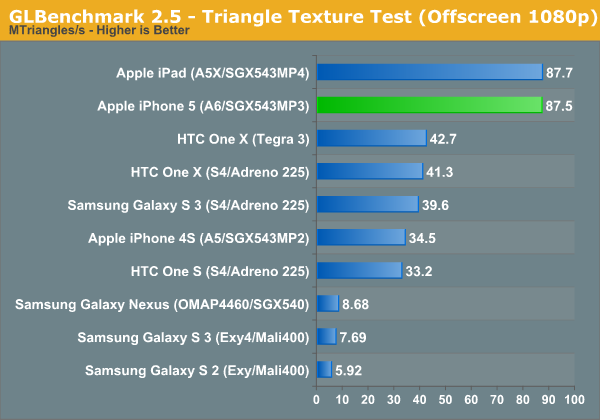
The fragment lit texture test does very well on the iPhone 5, once again when you take into account the much lower resolution of the 5's display performance is significantly better than on the iPad:
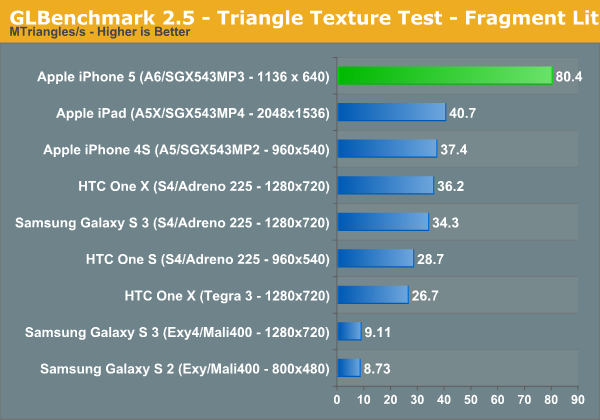
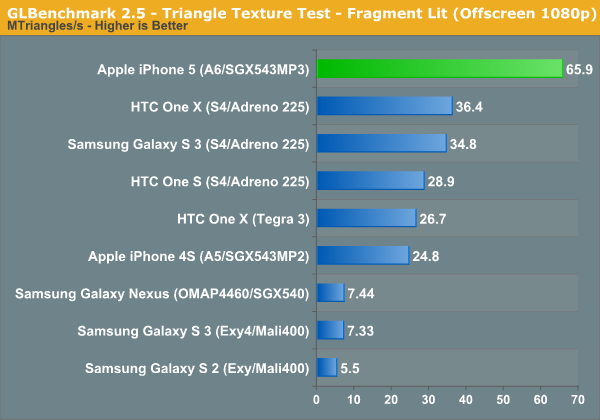
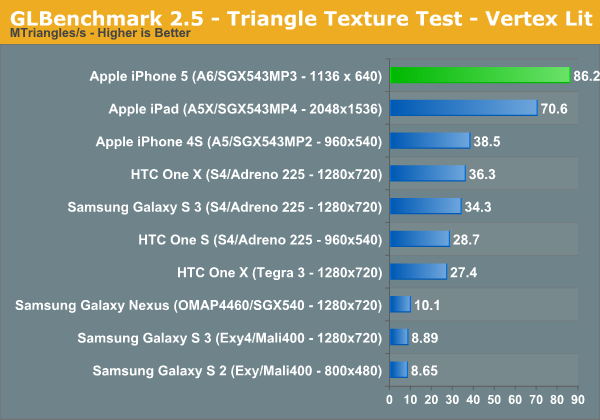
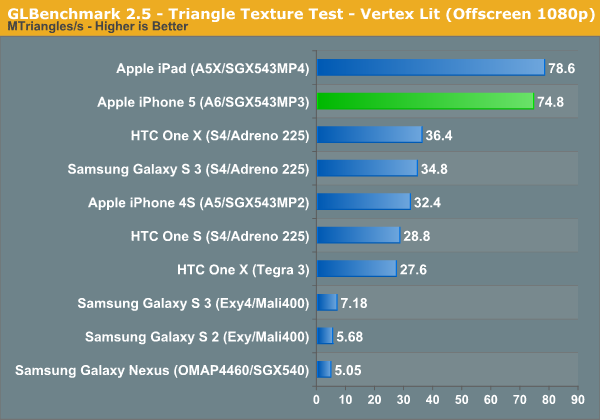
The next set of results are the gameplay simulation tests, which attempt to give you an idea of what game performance based on Kishonti's engine would look like. These tests tend to be compute monsters, so they'll make a great stress test for the iPhone 5's new GPU:
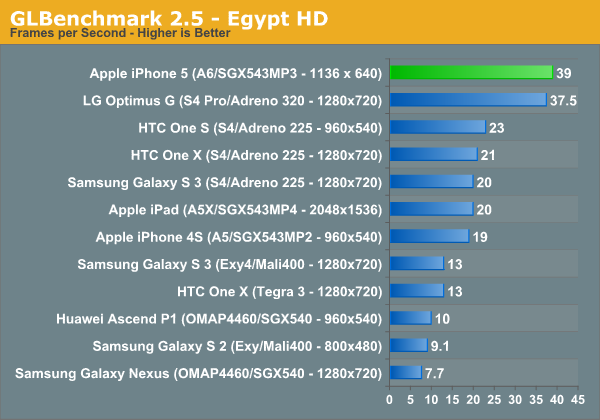
Egypt HD was the great equalizer when we first met it, but the iPhone 5 does very well here. The biggest surprise however is just how well the Qualcomm Snapdragon S4 Pro with Adreno 320 GPU does by comparison. LG's Optimus G, a device Brian flew to Seoul, South Korea to benchmark, is hot on the heels of the new iPhone.
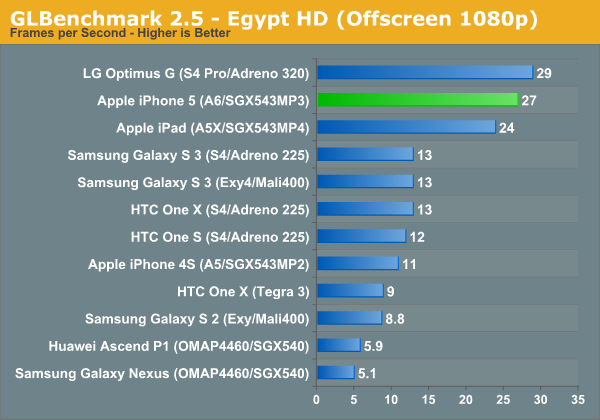
When we run everything at 1080p the iPhone 5 looks a lot like the new iPad, and is about 2x the performance of the Galaxy S 3. Here, LG's Optimus G actually outperforms the iPhone 5! It looks like Qualcomm's Adreno 320 is quite competant in a phone.
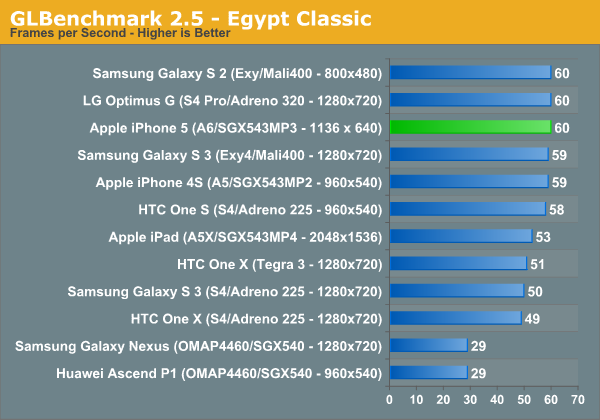
The Egypt classic tests are much lighter workloads and are likely a good indication of the type of performance you can expect from many games today available on the app store. At its native resolution, the iPhone 5 has no problems hitting the 60 fps vsync limit.

Remove vsync, render at 1080p and you see what the GPUs can really do. Here the iPhone 5 pulls ahead of the Adreno 320 based LG Optimus G and even slightly ahead of the new iPad.
Once again, looking at GLBenchmark's on-screen and offscreen Egypt tests we can get a good idea of how the iPhone 5 measures up to Apple's claims of 2x the GPU performance of the iPhone 4S:
Removing the clearly vsync limited result from the on-screen Egypt Classic test, the iPhone 5 performs about 2.26x the speed of the 4S. If we include that result in the average you're still looking at a 1.95x average. As we've seen in the past, these gains don't typically translate into dramatically higher frame rates in games, but games with better visual quality instead.
Final Words
We still have a lot of work ahead of us, including evaluating the power profile of the new A6 SoC. Stay tuned for more data in our full review of the iPhone 5.


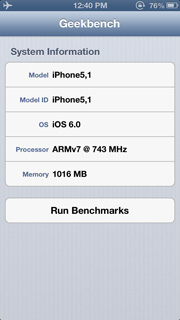

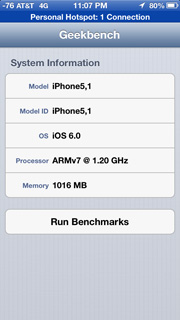












237 Comments
View All Comments
FrenchMac - Saturday, September 22, 2012 - link
Android has not been faster years. It s quite the opposite in fact. You cannot beat a platform where everything is built from Llvm compiler with code coming from a JIT java VM. Add to that the general lack of GPU optimizations of the UI and the lower quality of applications on Google Plays compare to those of the AppStore.Android has it s plus but it not in the raw performance area. That what I see for using both platforms at work.
Charbax - Saturday, September 22, 2012 - link
Android uses virtualization and compatible processes to reach as broad a range of hardware as possible. They can progressively optimize how the virtualization is done, hooking in more and more hardware acceleration mainly because all the different hardware platforms use more and more compatible hardware acceleration architecture. The point is Android has FOR YEARS been seconds faster than iOS at MOST actual real use cases, for example ask people of different experience levels to accomplish the top-20 most important smartphone tasks, Android has been faster than iOS at these real performance tests since Android 1.6 in 2009.akdj - Saturday, September 22, 2012 - link
"The point is Android has FOR YEARS been seconds faster than iOS at MOST actual real use cases, for example ask people of different experience levels to accomplish the top-20 most important smartphone tasks, Android has been faster than iOS at these real performance tests since Android 1.6 in 2009."Any chance you could point is to this 'study'? I'm curious as I've been developing now for Android for 4 years, iOS for 3. In my experience, as well as the dozen or so full time colleagues I regularly develop with--we've found the inverse to be true. From the top down. Whether we are talking UI fluidity, app launching, browser speed/loading, email fetching and all around application performance to memory management...iOS is clearly the victor. Whether benchmarking (artificial) or real world, perceived performance (subjective)--in an apples to apples comparison (no pun, talking about current hardware vs current hardware) Apple's devices are clearly 'faster'
I wish...I really do that Google would actually close down it's open source idea a bit. Take more control over both manufacturing AND carriers/operators. The integration between soft, middle and hardware that Apple imposes clearly benefits end user experience. Google has the ability to do the same with their Nexus devices...but when it comes to other manufacturers abiding by a simple set of rules set by Google, I think drastic changes could be made is some areas of Android. Namely fluidity, perceived speed....and software development.
FrenchMac - Saturday, September 22, 2012 - link
As a developer on both platforms, I notice the same thing. Everything in iOS feel faster. It show that android has been created before the multi touch era. Seriously, android 1.6 was soooo slow...Even the 2.x serie has't much optimization in the 3d department for the ui.
pmartin - Wednesday, October 3, 2012 - link
Please show us where you found this information?xype - Saturday, September 22, 2012 - link
You’re just sounding butthurt here. How many people will have a rooted Android device? "Real world" performance tests should be done with what most people will be using.If you had one bit of real world experience developing either software or hardware you’d understand that putting aside 10 engineers to optimize a platform for a single benchmark suite is retarded, and double retarded if you are on a tight, 12-month release cycle schedule.
And, no, Android hasn’t been "much faster" than iOS. It’s been faster in some areas, perhaps, and slower in others (UI performance being the most obvious one—you can’t "fake" smooth animations vs jerky ones). It would actually take holding more than one device in your hands to understand that, though, and implying that AnandTech is too stupid to catch any kind of "benchmark tweaking" from either Apple or any other hardware manufacturer is insulting.
All in all, you can’t handle the fact that Apple is capable of producing a solid CPU/GPU combination. Which is surprising, seeing how they have shit loads of money to throw at the problem if they wanted to.
Charbax - Saturday, September 22, 2012 - link
You're retarded if you think a $600 Billion company is going to choose not to use 10 benchmark cheating engineers if that can make some people online believe they are faster.The point is rooted Android is not necessary faster at everything, it's faster at BENCHMARKS ONLY. The point is how OS is made influences how benchmarks score. And the OS does not need to be fast everywhere, it just needs to render the benchmarks faster!!! There is no proof that all elements of benchmarks are fully rendered, they can easily code OS to skip rendering aspects, skip frames even, just show a faster scrore.
I'm not saying Apple's ARM processors are crap, I'm saying Android ARM Processors are FASTER or at the least comparable. It's just moronic to suggest that the whole world of processor designers can't match or outcompete one little Apple process design team.
darkcrayon - Saturday, September 22, 2012 - link
LOL... I mean really. Do you even read what you write?You called another poster "retarded" because, of *course* Apple hired "benchmark cheating engineers" to rig the benchmarks? :) That's really just so obvious that you'd have to be "retarded" to not see it?
I'm sure it's possible though! So, show us some real world applications where the iPhone 5 can't keep up with these FASTER (just slower in benchmarks) "Android" ARM processors.
serversurfer - Sunday, September 23, 2012 - link
"You're retarded if you think a $600 Billion company is going to choose not to use 10 benchmark cheating engineers if that can make some people online believe they are faster."Well said. I thought everyone knew the only reason Android appeared to come close to iOS levels of performance is because Google hired 10 guys to doctor the benchmark. Hell, they even went so far as to create their own benchmark that was "more realistic." I mean, how transparent is that??
I just can't believe how many sheep continue to buy Android phones, just because someone told them "it's almost as good as an iPhone." Don't these people see that Google are just a bunch of anti-competitive patent bullies? They're trying to ban Apple products because they claim they have a patent on messaging FFS. Why can't they just put out a competitive product instead? Are they afraid of innovation and competition?
Retarded indeed!!
darkcrayon - Saturday, September 22, 2012 - link
Notice that Apple hasn't posted any benchmarks, nor have they really gone on and on about the performance of their new SoC. All they really say is that it has 2X the CPU and GPU performance of the A5. If anything, they're seriously downplayed just how well this chip performs compared to the competition, even when the competition is using devices nearly twice the size to house their respective chips and huge batteries.iOS has always "felt" much faster than Android even on much more modest CPUs. Now that Apple has released a chip that has CPU performance on par or better than what's being used in current Android devices, that gap is only going to be wider.
I would like to see some real world apps that actually "do" something to compare performance. Thing is, it seems most of those types of apps exist only on iOS (advanced audio apps that are CPU limited on the #s of real time effects and simultaneous tracks for example).